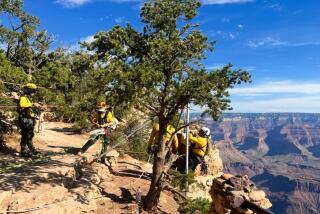No Fear of Flying: Sky-Diving Made Easy by Modern Equipment
SAN DIEGO — Over the past 32 years, Jerry Bourquin has watched sky-diving evolve from the days when he modified Air Force emergency parachutes so he would be able to steer them to the present, when some parachute teams are making formations with 130 jumpers.
For Bourquin, sky-diving isn’t merely jumping out of a plane and letting the parachute carry him to the ground. He has taken it few steps further.
Bourquin, who was in the Army for 22 years, began parachuting in 1958 and exhibition sky-diving in 1959, when the activity was just getting started in the United States. He was one of the original members of the Army parachute team, the Golden Knights at Fort Bragg, N.C.
After retiring from the Army, Bourquin worked as a test pilot for Hiller Aviation for 14 years in Port Angeles, Wash. In 1986, his wife, Jean, passed away; Bourquin finally decided to leave Washington this year. He traveled to different areas to find the best weather and conditions for jumping and decided on San Diego, where you can jump year-round. He moved here in January and is the chief instructor at the San Diego Air Sports Center in Jamul.
Bourquin said he doesn’t sky-dive to get a “daredevil feeling” and doesn’t think most jumpers do.
“It’s all done with safety in mind,” he said. “Fun comes with that.”
Bourquin said free falls in three- and four-way formations are done with a specific altitude at which the formation is broken apart and another at which the rip cord must be pulled.
There are four license ranges, from A, the lowest, to D. A and B jumpers must open their parachutes at 3,000 feet, and C and D jumpers can go as low as 2,000 feet. Two hundred jumps are required for a D license. Bourquin has taken 2,100, 2,018 free falls and the others static line jumps (in which a line is hooked to the aircraft, automatically deploying the parachute when the jump is made). He is certified D22, which means he was the 22nd person in the United States to get a D license. He accomplished that in 1960.
“For me, it was just a challenge to do something well on my own,” Bourquin said. “Not only in the actual jumping but being able to control my body in free fall, to do turns and loops and barrel rolls, but also to be able to compete. I was on four U.S. parachute teams, and that was a challenge to myself to accomplish that.”
When Bourquin started sky-diving, baton-passing was beginning. Two jumpers would come together and pass a baton about 12 inches long between each other. The next step, formations of up to six or seven, was taken in the early ‘60s. Bourquin said the really big formations began to flourish in the past 15 years.
The most dramatic changes Bourquin said he has seen over the years are in equipment, particularly the parachute. When he first began, the Golden Knights would modify the Air Force emergency parachutes by cutting a triangle, called a gore, out of the back to allow them to steer. The parachutes were round and came down fairly fast because of their size and the porousness of the material, which allowed air to flow through rapidly.
Parachutes were later made of nylon that had less space between the fibers, slowing the jumper’s descent. Manufacturers then began experimenting with squares, which developed into the parachutes used today. One of the benefits is glide ratio. For every foot the jumper descends, he or she can glide forward three feet.
“It gives you the ability to travel great distances compared to what we used in the beginning,” Bourquin said.
Bourquin said that one of the bad things about the new parachutes is that they fly so well, people don’t concentrate hard enough on learning when to “spot,” selecting the correct time to leave the aircraft so they will come down at the landing site. Now, a jumper can begin off target and still descend in the right place.
“When we jumped with the round parachutes, you had to be in the right spot to open to have any semblance of accuracy,” Bourquin said. “All the new parachutes do is make people a little lazy in their jump-mastering and their spotting.
“It’s a fantastic parachute,” Bourquin said. “It’s fun to fly, and now they do what they call canopy-relative work, where you can get a number of jumpers in the air and they can actually hook up, stack and then they fly around as a unit and separate for landing.”
Because of the glide jumpers get with the square parachutes, Bourquin said the injury rate has dropped to almost nothing.
“Before, you came down rather rapidly, and if you didn’t do a good PLF, parachute landing fall (a method of rolling to the ground to absorb the impact), you could be injured, and very seldom did you do a standing landing,” Bourquin said. “Now, it’s standard to do a standing landing, and very seldom do you see a PLF, it’s just reversed. It’s really nice for new jumpers.”
Because of the innovations in sky-diving, people can take a five- to six-hour classroom course and take their first jump the same day. When students make their first jumps, they are attached to a static line.
The first two static line jumps allow the student to learn body position and how to count to know when the parachute should be deployed. The next three train the new jumper the sequence leading up to pulling the rip cord.
“They learn what it’s going to be like when they first deploy their parachute on their own,” Bourquin said. “If they’ve done that properly, we’ll allow them to make their first free fall, where they deploy their own parachute.”
Before the jumper goes off student status, after 15 jumps, a course is given on how to pack the parachute. Students are then allowed to have their own gear.
Bourquin said people who try sky-diving once usually return. Those who can’t decide whether to take the static line course often take what is called a tandem ride.
The potential student is attached to a jump master with a hook from the new jumper’s back to the jump master’s front. They leave the aircraft at about 9,500 feet, open at 4,000 feet and ride to the ground on an extra-large parachute designed for two people. Bourquin said it gives a potential student the feeling that he or she is in free fall.
Prices at the San Diego Air Sports Center for ground school, equipment use and one jump are $115 for students or military, $135 for everybody else. Each subsequent jump is $29, including equipment.
Bourquin says he jumps three of four times a day and will continue to do so until he can’t jump anymore.
More to Read
Sign up for The Wild
We’ll help you find the best places to hike, bike and run, as well as the perfect silent spots for meditation and yoga.
You may occasionally receive promotional content from the Los Angeles Times.






